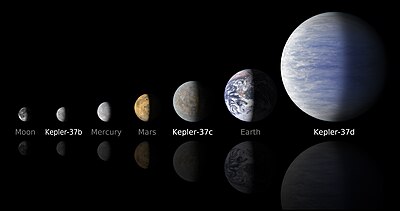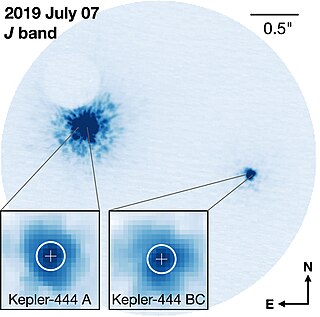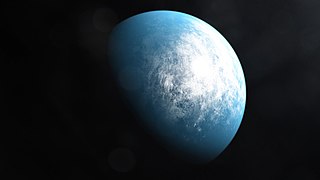
Below is a list of the smallest exoplanets so far discovered, in terms of physical size, ordered by radius.

Below is a list of the smallest exoplanets so far discovered, in terms of physical size, ordered by radius.
The sizes are listed in units of Earth radii (R🜨). All planets listed are smaller than Earth and Venus, up to 0.7 Earth radii. The NASA Exoplanet Archive is used as the main data source. [1] [2]
| Exoplanet | Radius (R🜨) | Notes and references |
|---|---|---|
| SDSS J1228+1040 b (SDSS J122859.92+104033.0 b, WD 1226+110 b) | 0.010+0.0504 −0.0085 [3] [4] | Extrasolar planetesimal. Likely a remnant iron core. Radius is in the range of 1.2 –120 km. [3] |
| WD 1145+017 b | ~0.03 [5] | Disintegrating planetesimal, likely one of several orbiting its star. Likely about one-tenth the mass of Ceres and ~200 km in radius. [5] |
| Ceres | 0.0742 | Shown for comparison |
| Pluto | 0.1863 | Shown for comparison |
| Moon | 0.2725 | Shown for comparison |
| Kepler-37b | 0.3098+0.0059 −0.0076 | Smallest known exoplanet. [6] [7] |
| PSR B1257+12 b (Draugr) | ~0.338 | Least massive known exoplanet, at 0.02 Earth masses. Radius estimated from mass-radius relationship. [8] |
| Kepler-1520b | ≲0.36 | Disintegrating planets with poorly known radii, all thought to be smaller than Mercury. [9] [10] |
| KOI-2700b | ||
| K2-22b | ||
| Mercury | 0.3826 | Shown for comparison |
| Kepler-444b | 0.403+0.016 −0.014 | [11] |
| Ganymede | 0.413 | Shown for comparison |
| Kepler-102b | 0.460±0.026 | [7] |
| Kepler-444c | 0.497+0.021 −0.017 | [11] |
| Kepler-1971b (KOI-4777.01) | 0.51±0.03 | [12] |
| Kepler-1994b | 0.51+0.06 −0.05 | [13] |
| Kepler-1308b | 0.52+0.06 −0.05 | |
| Kepler-444d | 0.530+0.022 −0.019 | [11] |
| Mars | 0.5325 | Shown for comparison |
| Kepler-62c | 0.54±0.03 | |
| Kepler-444e | 0.546+0.017 −0.015 | [11] |
| Gliese 238 b | 0.566±0.014 | [14] |
| Kepler-102c | 0.567±0.028 | [7] |
| Kepler-42d | 0.57±0.18 | |
| Kepler-1583b | 0.60+0.09 −0.05 | |
| Kepler-1998b | 0.6+0.08 −0.04 | [15] |
| Kepler-1087b | 0.61+0.17 −0.05 | |
| K2-89b | 0.615±0.080 | |
| Kepler-1877b | 0.624 | |
| K2-137b | 0.64±0.10 | |
| Kepler-1371c | 0.64+0.07 −0.05 | |
| Kepler-138b | 0.64±0.02 | [16] |
| Kepler-1130d | 0.645 | |
| Kepler-1351b | 0.65+0.05 −0.04 | |
| Kepler-1542c | 0.65+0.09 −0.06 | |
| Kepler-271d | 0.66±0.05 | |
| Kepler-431c | 0.668 | |
| Kepler-1558b | 0.68+0.06 −0.04 | |
| LHS 1678 b | 0.685+0.037 −0.035 | [17] |
| K2-116b | 0.69±0.04 | |
| Kepler-141b | 0.69±0.05 | |
| K2-297b (EPIC 201497682 b) | 0.692+0.059 −0.048 | |
| Gliese 367 b (Tahay) | 0.699±0.024 | Smallest known exoplanet within 10 parsecs. [18] |
| Kepler-1349b | 0.700+0.630 −0.110 | |
| Kepler-378c | 0.70±0.05 |
Kepler-37e is listed with a radius of 0.37±0.18 R🜨 in the Exoplanet Archive based on KOI data, but the existence of this planet is doubtful, [19] and assuming its existence, a 2023 study found a mass of 8.1±1.7 M🜨 , inconsistent with such a small radius. [20]
KOI-6705.01, listed as a potential very small planet in the KOI dataset, was shown to be a false positive in 2016. [21]
Below shows a list of Kepler and TESS candidates below 0.7 R🜨 that have yet to be confirmed.
| Kepler object of interest | Radius (R🜨) | Notes and references |
|---|---|---|
| KOI-4582.01 | 0.35 [22] | |
| KOI-2298.03 | 0.36 [22] | |
| KOI-2169.04 | 0.37 [22] | |
| KOI-7174.01 | 0.37 [22] | |
| KOI-8012.01 | 0.42 [22] | |
| KOI-6860.01 | 0.43 [22] | |
| KOI-2059.02 | 0.44 [22] | |
| KOI-304.02 | 0.46 [22] | |
| KOI-7793.01 | 0.46 [22] | |
| KOI-2678.02 | 0.48 [22] | |
| KOI-6631.01 | 0.48 [22] | |
| KOI-2421.02 | 0.48 [22] | |
| KOI-5974.01 | 0.49 [22] | |
| KOI-3444.03 | 0.5 [22] | |
| KOI-2295.01 | 0.52 [22] | |
| KOI-7863.01 | 0.52 [22] | |
| KOI-2612.02 | 0.53 [22] | |
| KOI-4657.01 | 0.54 [22] | |
| KOI-8257.01 | 0.54 [22] | |
| KOI-115.03 (Kepler-105d) | 0.55+0.08 −0.07 | [23] |
| KOI-2421.01 | 0.55 [22] | |
| KOI-4097.02 | 0.55 [22] | |
| KOI-7645.01 | 0.55 [22] | |
| KOI-3208.01 | 0.56 [22] | |
| KOI-6763.01 | 0.56 [22] | |
| KOI-2859.03 | 0.57 [22] | |
| KOI-4146.02 | 0.57 [22] | |
| KOI-2859.04 | 0.57 [22] | |
| KOI-7873.01 | 0.57 [22] | |
| TOI-4307.02 | 0.57±0.14 [24] | |
| KOI-2657.01 | 0.58 [22] | |
| KOI-8277.01 | 0.58 [22] | |
| KOI-4296.01 | 0.59 [22] | |
| KOI-3196.01 | 0.59 [22] | |
| KOI-5692.01 | 0.59 [22] | |
| KOI-1964.01 | 0.6 [22] | |
| KOI-4407.01 | 0.6 [22] | |
| KOI-4871.01 | 0.6 [22] | |
| KOI-5211.01 | 0.6 [22] | |
| KOI-7888.01 | 0.6 [22] | |
| KOI-3184.03 | 0.6 [22] | |
| KOI-8183.01 | 0.6 [22] | |
| KOI-3083.02 | 0.61 [22] | |
| KOI-4421.01 | 0.61 [22] | |
| KOI-4716.01 | 0.61 [22] | |
| KOI-3102.01 | 0.61 [22] | |
| KOI-7032.01 | 0.61 [22] | |
| KOI-1843.03 | 0.61+0.12 −0.08 | [25] |
| KOI-1499.02 | 0.62 [22] | |
| KOI-605.02 | 0.62 [22] | |
| KOI-7676.01 | 0.62 [22] | |
| KOI-4849.01 | 0.62 [22] | |
| KOI-365.02 | 0.62 [22] | |
| KOI-7116.01 | 0.62 [22] | |
| KOI-4421.02 | 0.62 [22] | |
| KOI-7949.01 | 0.62 [22] | |
| KOI-2029.04 | 0.63 [22] | |
| KOI-6889.01 | 0.63 [22] | |
| KOI-2636.02 | 0.63 [22] | |
| KOI-3248.01 | 0.64 [22] | |
| KOI-5213.01 | 0.64 [22] | |
| KOI-6276.01 | 0.64 [22] | |
| KOI-7617.01 | 0.64 [22] | |
| KOI-7903.01 | 0.64 [22] | |
| KOI-7925.01 | 0.64 [22] | |
| KOI-8174.01 | 0.64 [22] | |
| KOI-3083.03 | 0.65 [22] | |
| KOI-4875.01 | 0.65 [22] | |
| KOI-4808.01 | 0.65 [22] | |
| KOI-6568.01 | 0.65 [22] | |
| KOI-1619.01 | 0.66 [22] | |
| KOI-3111.02 | 0.66 [22] | |
| KOI-2859.05 | 0.66 [22] | |
| KOI-3017.01 | 0.67 [22] | |
| KOI-4907.01 | 0.67 [22] | |
| KOI-1616.02 | 0.67 [22] | |
| KOI-6299.01 | 0.67 [22] | |
| KOI-8211.01 | 0.67 [22] | |
| KOI-2593.02 | 0.68 [22] | |
| KOI-4605.01 | 0.68 [22] | |
| KOI-7832.01 | 0.68 [22] | |
| KOI-7483.01 | 0.68 [22] | |
| KOI-2623.02 | 0.68 [22] | |
| KOI-7924.01 | 0.68 [22] | |
| KOI-7628.01 | 0.69 [22] | |
| KOI-4129.01 | 0.69 [22] | |
| KOI-4822.01 | 0.69 [22] | |
| KOI-6600.01 | 0.69 [22] |

A Super-Earth is a type of exoplanet with a mass higher than Earth's, but substantially below those of the Solar System's ice giants, Uranus and Neptune, which are 14.5 and 17 times Earth's, respectively. The term "super-Earth" refers only to the mass of the planet, and so does not imply anything about the surface conditions or habitability. The alternative term "gas dwarfs" may be more accurate for those at the higher end of the mass scale, although "mini-Neptunes" is a more common term.
A Kepler object of interest (KOI) is a star observed by the Kepler space telescope that is suspected of hosting one or more transiting planets. KOIs come from a master list of 150,000 stars, which itself is generated from the Kepler Input Catalog (KIC). A KOI shows a periodic dimming, indicative of an unseen planet passing between the star and Earth, eclipsing part of the star. However, such an observed dimming is not a guarantee of a transiting planet, because other astronomical objects—such as an eclipsing binary in the background—can mimic a transit signal. For this reason, the majority of KOIs are as yet not confirmed transiting planet systems.
Kepler-20 is a star about 934 light-years from Earth in the constellation Lyra with a system of at least five, and possibly six, known planets. The apparent magnitude of this star is 12.51, so it cannot be seen with the unaided eye. Viewing it requires a telescope with an aperture of 15 cm (6 in) or more. It is slightly smaller than the Sun, with 94% of the Sun's radius and about 91% of the Sun's mass. The effective temperature of the photosphere is slightly cooler than that of the Sun at 5466 K, giving it the characteristic yellow hue of a stellar class G8 star. The abundance of elements other than hydrogen or helium, what astronomers term the metallicity, is approximately the same as in the Sun. It may be older than the Sun, although the margin of error here is relatively large.

Kepler-42, formerly known as KOI-961, is a red dwarf located in the constellation Cygnus and approximately 131 light years from the Sun. It has three known extrasolar planets, all of which are smaller than Earth in radius, and likely also in mass.
Kepler-102 is a star 353 light-years away in the constellation of Lyra. Kepler-102 is less luminous than the Sun. The star system does not contain any observable amount of dust. Kepler-102 is suspected to be orbited by a binary consisting of two red dwarf stars, at projected separations of 591 and 627 AU.

Kepler-138, also known as KOI-314, is a red dwarf located in the constellation Lyra, 219 light years from Earth. It is located within the field of vision of the Kepler spacecraft, the satellite that NASA's Kepler Mission used to detect planets transiting their stars.
K2-3, also known as EPIC 201367065, is a red dwarf star with three known planets. It is on the borderline of being a late orange dwarf/K-type star, but because of its temperature, it is classified as a red dwarf.

Kepler-444 is a triple star system, estimated to be 11.2 billion years old, approximately 119 light-years (36 pc) away from Earth in the constellation Lyra. On 27 January 2015, the Kepler spacecraft is reported to have confirmed the detection of five sub-Earth-sized rocky exoplanets orbiting the main star. The star is a K-type main sequence star. All of the planets are far too close to their star to harbour life forms.
The small planet radius gap is an observed scarcity of planets with radii between 1.5 and 2 times Earth's radius, likely due to photoevaporation-driven mass loss. A bimodality in the Kepler exoplanet population was first observed in 2011 and attributed to the absence of significant gas atmospheres on close-in, low-mass planets. This feature was noted as possibly confirming an emerging hypothesis that photoevaporation could drive atmospheric mass loss This would lead to a population of bare, rocky cores with smaller radii at small separations from their parent stars, and planets with thick hydrogen- and helium-dominated envelopes with larger radii at larger separations. The bimodality in the distribution was confirmed with higher-precision data in the California-Kepler Survey in 2017, which was shown to match the predictions of the photoevaporative mass-loss hypothesis later that year.

TOI-700 d is a near-Earth-sized exoplanet, likely rocky, orbiting within the habitable zone of the red dwarf TOI-700, the outermost planet within the system. It is located roughly 101.4 light-years (31.1 pc) away from Earth in the constellation of Dorado. The exoplanet is the first Earth-sized exoplanet in the habitable zone discovered by the Transiting Exoplanet Survey Satellite (TESS).
Kepler-1544b is a potentially habitable exoplanet announced in 2016 and located 1138 light years away, in the constellation of Cygnus.
[...]the radii are not known but are thought to be smaller than Mercury (0.36R⊕).
We confirmed the disintegrating-planet scenario of KOI 2700b.